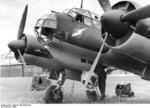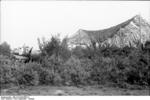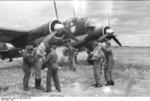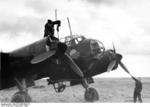Ju 88
| Country | Germany |
| Manufacturer | Junkers |
| Primary Role | Medium Bomber |
| Maiden Flight | 21 December 1936 |
Contributor: C. Peter Chen
ww2dbaseWhen Hermann Göring and the German Luftwaffe asked for a multi-role aircraft from the aircraft manufacturing firm Junkers, the Ju 88 design became the answer. The versatile twin-engined aircraft entered the war the very same day Germany invaded Poland, with various variations of them each suitable for level bombing, torpedo bombing, dive bombing, close ground support, and reconnaissance. Of these requested features, dive bombing was the item that changed the design the most as the strengthened fuselage, dive brakes, and other dive bombing related enhancements nearly doubled the weight. By the end of 1939, only 60 were delivered to Luftwaffe units, but the individual crews, which was comprised of a pilot, an observer, a radio operator/rear gunner, and a flight engineer/waist gunner, provided a favorable review during the first few missions with these new bombers, especially commenting that they could absorb a great deal of damage in action; one of the few complaints was that they were difficult to handle on takeoffs and landings. The crew members sat close together in the aircraft for the purpose of improved communications. During the Battle of Britain, Ju 88 aircraft were put to the test. To Göring's disappointment, they did not perform as well as expected. Even though they were very fast for bombers, they were still unable to escape the faster and more maneuverable British Spitfire and Hurricane fighters. The heavy losses prompted several refittings of the aircraft, including heavier armor in the cockpit area and upgraded defensive weaponry. During the later stages of the war when Germany was subjected to regular night time bombings by the British, Ju 88 aircraft were employed as night fighters, proving their versatile nature. By the end of the war, they were nearly perfected, coupled with a more powerful engine, but by then it was already too late for Germany.
ww2dbaseSources:
Paul Deichmann, Spearhead for Blitzkrieg
Stephen Bungay, The Most Dangerous Enemy
Wikipedia
Last Major Revision: Sep 2010
Ju 88 Timeline
| 13 Jul 1944 | The secret of the German FuG 227 Flensburg equipment, which could home-in on RAF Monica radars, was revealed when a Luftwaffe pilot landed his Junkers Ju 88G-1 night fighter by mistake at RAF Woodbridge in Suffolk, England, United Kingdom. In addition the capture of this aircraft's FuG 220 radar would permit British scientist to find a way of jamming its signal within a matter of weeks. |
SPECIFICATIONS
Ju 88C-6c
| Machinery | Two liquid cooled, 12-cylinder inverted-Vee, Junkers Jumo 211J-1 (or J-2) rated at 1,340hp each |
| Armament | 3x20mm machine guns, 3x7.9mm machine guns, 1x13mm machine gun, optional 2x20mm machine guns, 3,000kg load of bombs |
| Crew | 3 |
| Height | 5.06 m |
| Wing Area | 54.50 m² |
| Weight, Empty | 9,060 kg |
| Weight, Loaded | 12,350 kg |
| Speed, Maximum | 488 km/h |
| Speed, Cruising | 423 km/h |
| Service Ceiling | 9,900 m |
| Range, Normal | 1,980 km |
Ju 88G-1
| Machinery | Two 14-cylinder, air cooled, BMW 801D-2 radials rated at 1,700hp each |
| Armament | 4x20mm machine guns, 1x13mm machine gun, optional 2x20mm machine guns, 3,000kg load of bombs |
| Crew | 3 |
| Span | 20.08 m |
| Length | 15.50 m |
| Height | 5.07 m |
| Wing Area | 54.50 m² |
| Weight, Empty | 9,081 kg |
| Weight, Loaded | 13,095 kg |
| Weight, Maximum | 14,690 kg |
| Speed, Maximum | 573 km/h |
| Service Ceiling | 8,840 m |
| Range, Normal | 2,500 km |
Ju 88G-7b
| Machinery | Two liquid cooled, 12-cylinder inverted-Vee, Junkers Jumo 213E rated at 1,725hp each |
| Armament | 4x20mm machine guns, 2x20mm machine guns, optional 2x20mm machine guns, 3,000kg load of bombs |
| Crew | 3 |
| Height | 4.85 m |
| Wing Area | 54.50 m² |
| Weight, Empty | 9,300 kg |
| Weight, Loaded | 13,100 kg |
| Weight, Maximum | 14,675 kg |
| Speed, Maximum | 626 km/h |
| Speed, Cruising | 560 km/h |
| Service Ceiling | 10,000 m |
| Range, Normal | 2,250 km |
Ju 88A-4
| Machinery | Two Junkers Jumo 211J liquid-cooled inverted V-12 engine rated at 1,401hp each |
| Armament | 1x7.92mm forward MG 81J machine gun, 2x7.92mm dorsal MG 81J machine guns, 1x2x7.92mm ventral MG 81Z twin machine gun, up to 3,000kg of bombs or 2x LT torpedoes |
| Crew | 4 |
| Span | 20.08 m |
| Length | 14.36 m |
| Height | 5.07 m |
| Wing Area | 54.70 m² |
| Weight, Loaded | 8,550 kg |
| Weight, Maximum | 14,000 kg |
| Speed, Maximum | 510 km/h |
| Service Ceiling | 9,000 m |
| Range, Maximum | 2,430 km |
Ju 88P-3
| Machinery | Two Jumo 211J-2 inverted V-12 engines rated at 1420hp each |
| Armament | 4x37mm ventral BK 37 cannons, up to 6x7.92mm machine guns |
| Crew | 3 |
| Span | 20.00 m |
| Length | 14.85 m |
| Height | 4.85 m |
| Wing Area | 54.56 m² |
| Weight, Empty | 11,080 kg |
| Weight, Maximum | 12,670 kg |
| Speed, Maximum | 360 km/h |
| Service Ceiling | 5,500 m |
| Range, Maximum | 1,580 km |
Photographs
 |  |  |  |
Did you enjoy this article or find this article helpful? If so, please consider supporting us on Patreon. Even $1 per month will go a long way! Thank you. Share this article with your friends: Stay updated with WW2DB: |
Visitor Submitted Comments
All visitor submitted comments are opinions of those making the submissions and do not reflect views of WW2DB.
» Battle of Britain
Related Documents:
» German Luftwaffe Losses, Jul-Sep 1940
» Luftwaffe Bombing and Use of Gas in France
- » 1,150 biographies
- » 337 events
- » 43,917 timeline entries
- » 1,241 ships
- » 350 aircraft models
- » 207 vehicle models
- » 373 weapon models
- » 123 historical documents
- » 260 facilities
- » 470 book reviews
- » 28,538 photos
- » 432 maps
Captain Henry P. Jim Crowe, Guadalcanal, 13 Jan 1943
Please consider supporting us on Patreon. Even $1 a month will go a long way. Thank you!
Or, please support us by purchasing some WW2DB merchandise at TeeSpring, Thank you!
21 Dec 2013 09:55:25 AM
ESCAPE: DESTINATION SWITZERLAND
On April 30,1945 Junkers Ju-88G-6 code(C9+AR)of
8./NJG 5 flown by Hauptmann Hopf, Oberleutnant
Dressler, Oberleutnant Erhard and their wives and one child, took off at 01:30hrs, flying low to avoid allied fighters they landed at Dubendorf airfield at 05:15hrs.
Interned by Swiss authorities details about the crew and passengers and what happened after they arrived in Switzerland, haven't surfaced but it would be an interesting account of their escape.
LEAVE NOW OR NEVER:
How did they manage to smuggle their wives and child aboard, fuel the aircraft, how did they manage to take off without authorization. Everything must have been planned to the last minute, escape Germany the skill in airmanship, flying low to avoid allied fighters and arrive in Switzerland.
Swiss Air Force personnel took charge of the Ju88
all Luftwaffe markings were painted out and replaced with Swiss markings. In 1949 the Swiss decided to have the aircraft scrapped. It would be something to see it in the Swiss Air Force Museum today...
To learn more about the Junkers Ju88 please click on all the file photographs...